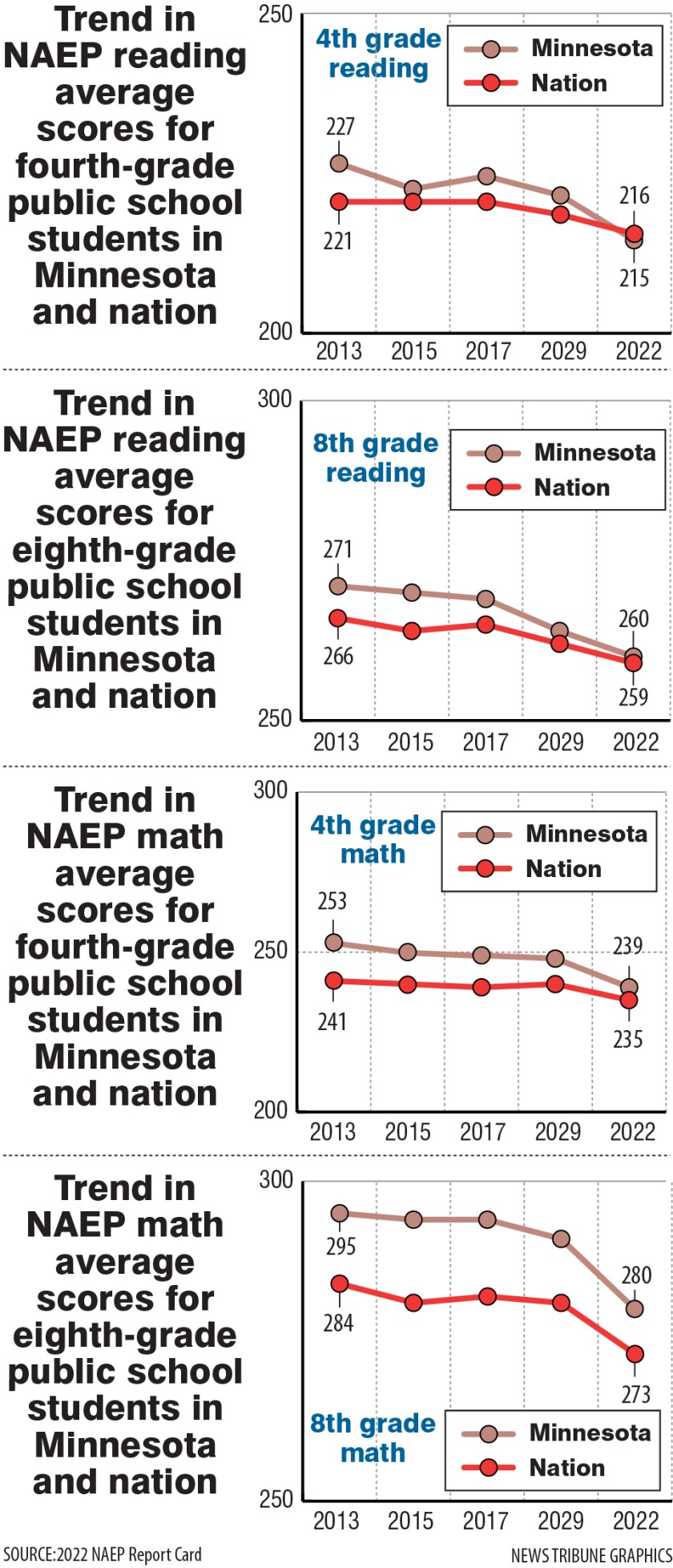ST. PAUL — Results from a national education assessment show Minnesota public school students’ reading and math scores significantly declined during the pandemic, with eighth-graders showing their worst performance in math since 1990.
The spring 2022 results released Monday, Oct. 24, show Minnesota eighth-graders' math test scores dropped by 11 points from 2019, placing the state among the 10 biggest drops in that age group nationally. No state reported gains in math performance for fourth- and eighth-graders since the last assessment, and nearly all states, including Minnesota, saw reading scores drop.
ADVERTISEMENT
Test scores for students across the U.S. have seen significant drops since the beginning of the COVID-19 pandemic, a trend many have blamed on remote learning and other disruptions caused by measures aimed at slowing the spread of the virus. However, there were signs of decline predating remote learning and pandemic restrictions, said Minnesota Department of Education spokesman Kevin Burns.

“The most recent data continues trends that we have seen beginning in 2017, prior to COVID,” he said in a statement. “We expected declines, given the disruption everyone experienced during the pandemic, but that doesn’t make these results easier to see. While Minnesota student scores outpace national scores, we must work diligently to take the necessary steps to help all students, across all grades, achieve.”
The National Assessment of Educational Progress measures educational achievement on a scale of 0-500. Minnesota eighth-graders had an average math score of 280 in the 2022 assessment, down from 291 in 2019.
The last time Minnesota students scored that low on the national math assessment was 1990, when the state’s average score was 278. Meanwhile, fourth-grade students saw their scores drop 9 points from 248 to 239, a low not seen since 2000. Minnesota math scores remained slightly above the 2022 national averages of 274 for eighth-graders and 236 for fourth-graders.
Minnesota students reading scores also declined among fourth- and eighth-graders. Fourth-grade students saw their scores drop from 222 to 216, just 1 point below the national average, while eighth-grade students saw a drop of 264 to 260, matching the decline in the national average.
The 2022 NAEP test report is one of the latest signs Minnesota students have been struggling in recent years.
According to 2022 statewide assessment scores released by the Minnesota Department of Education in August , the number of Minnesota K-12 students meeting grade-level standards for reading continues to decline. As the reading proficiency rate continued to drop, fewer than half of Minnesota students who took state standardized tests were proficient in math and science in 2022.
ADVERTISEMENT
Denise Specht, president of teachers union Education Minnesota, said the NAEP results are “disappointing, but not surprising” given the pandemic. In a statement on Minnesota’s performance in the national assessment, she called for the state to invest more resources in its education system.
“Most Minnesota schools have open jobs for teachers, education support professionals, and mental health care professionals — and the shortage is at crisis levels in some places,” she said. “Raising the academic achievement of students will require Minnesotans to stand up and demand their elected leaders provide the resources schools need to give every student access to a great educator, in a small class, in a welcoming and supportive school."
Others, such as Senate Assistant Majority Leader Roger Chamberlain, a Lino Lakes Republican who chairs the Senate education committee, said declining state and national assessment scores show that Minnesota needs to reassess how it approaches education rather than increase its funding.
"Today's test scores demonstrate the current leadership in education is failing kids. Minnesota students' reading scores dropped below Mississippi, despite record state funding and billions in federal COVID dollars in Minnesota,” the senator said, referring to the Legislature in 2021 approving the largest increase in state school funding in 15 years.
North and South Dakota
The Dakotas also experienced declining test scores, with the biggest losses in eighth-grade math performance.
North Dakota also saw its math scores significantly decline between 2019 and 2022, and the lowest average eighth-grade math score on the national assessment since 1990, when the average score was 281. Eighth-graders saw their reading scores drop from 263 to 258 and math scores drop from 286 to 278. Meanwhile, fourth-graders saw their reading scores drop from 221 to 218 and math scores drop from 243 to 240.
In a statement, North Dakota Superintendent of Public Instruction Kirsten Baesler called the scores disappointing.
ADVERTISEMENT
“We expected declines, given the disruption everyone experienced during the pandemic, but that doesn’t make these results easier to see,” Baesler said. “We must work diligently to take the necessary steps to help all students, across all grades, to achieve. This is a time to focus not just on recovery but on progress.”
Eighth-grade students in South Dakota saw average math scores drop from 287 in 2019 to 281 in 2022 while fourth-grade math scores dipped from 241 to 239. Average reading scores for eighth-graders dropped just 1 point from 263 to 262, while fourth-graders dropped from 222 to 218.

















